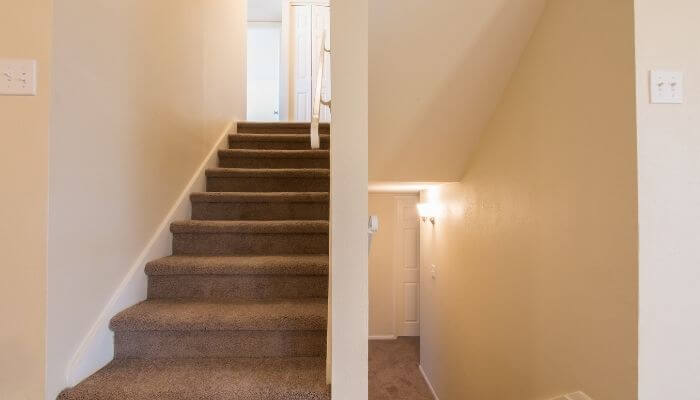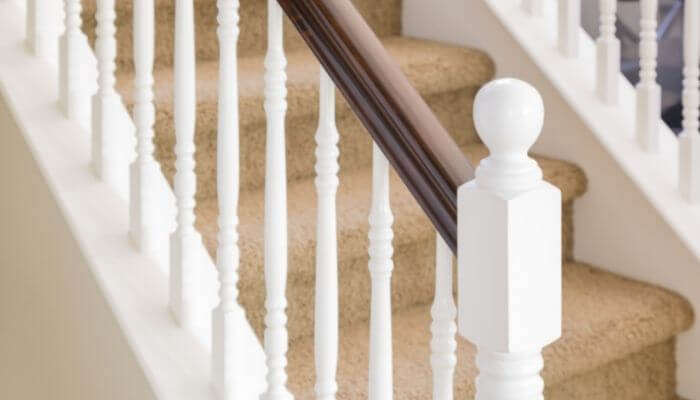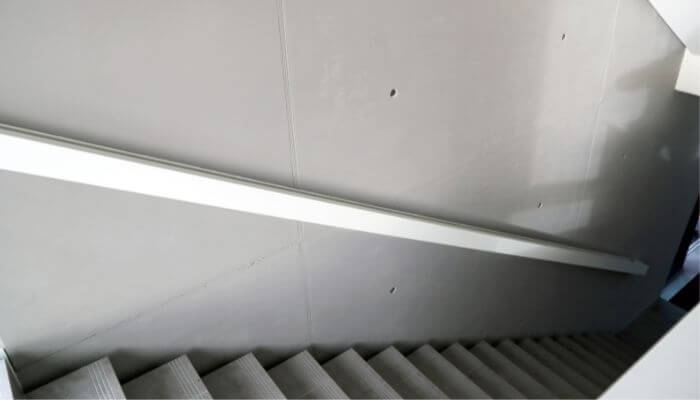Do you want to get rid of noisy steps? Do your stairs seem to squeak every time you use them?
In today’s article, we’re looking at how to soundproof stairs, but we’re also explaining to you the anatomy of a stairwell and why it matters in choosing the right sound-deadening technique.
If you just want to stop your stairs from squeaking rather than fully soundproofing the entire stairwell then we recommend you read how to make your stairs quieter.
Why Are Your Stairs Making Noise?
Since most people who are bothered by the noise that their stairs are making don’t necessarily work in construction, we’d like to note that there are several different components to a staircase.
You should know which one of them actually squeaks in order to be able to solve the problem, right?
Tackling a squeaking stair can be done by most people, but localizing the component that’s the culprit is the first and most important step.
There are five main parts in every staircase:
- Risers – the vertical parts of the stair
- Treads – the bit you stand on
- Banisters – the handrail
- Stringers – these look like a stair skirting board
- Balustrades – the components that make up the stair rail, this includes the baserail, spindles, posts and handrail.
The treads are the horizontal sides of the stairs where you can take your steps, while the risers are the vertical sides that effectively connect the treads.
The banisters, also known as the handrails, are located on the sides of the staircase. They’re the part you can run your hands on when climbing or going down the stairs.

Stringers are boards that run up the sides of the treads, as well as the risers. Their purpose is to ensure that the stairwell doesn’t tear apart, so they have to be made of quite durable material or a thicker surface.
Finally, the balustrades are the posts that are there to keep the banisters at a certain height that can make it easy and comfortable for anyone to hold them in case they lose their balance.
Locating The Noise
You can find the precise location of the noise by going up and down the stairs and closely listening to when the squeak occurs.
If the balustrade is making the noise, you’ll hear the same sound while you take two or three steps, not just one.
If several steps are at the root of the problem, write down their numbers. You can also use a marker, a tape, or even place a coin on each of them.
On each of the steps, stand in the center, move sideways, and then touch the risers with your heel just to make sure that they aren’t the ones that squeak (instead of the treads).
Move your weight forward and backward. Touch the tip of every step with your toes and push to find out if the margin is the culprit or not.
If you feel that the tip is what’s causing the problem, that might not actually be it — it could be a sign that a tread has come loose from its corresponding riser, for example.
If the step’s making noise on one side or the back, it could have become loose right at the stringer instead.
The Challenges Of Soundproofing Stairs
There are lots of parts that are combined in the making of a stairwell, so there could be several origins to the squeak you are hearing.
Fixing a noisy staircase can also be difficult if you live in a two or more storey house and the staircase goes from the first floor all the way up to the last.
This is due to the fact that all of the sounds are somehow transmitted from the bottom above. Some would describe it as a sound tunnel, with the squeak being picked up by the internal structure of the stairs. Plus, there’s nothing blocking the noise.
For example, if you were to knock on your staircase while being on your first floor, chances are that someone could hear the noise you’re making even if they’re on the second or third floor of your house.
Another reason for why stairs are so challenging to soundproof is a phenomenon called ‘reverberation’. There are many materials that do a poor job of blocking noise, such as the following:
- Wood
- Concrete
- Granite
- Metal
- Bricks
- Plaster
- Marble
If you’ve ever run up or down your stairs, you probably know that everyone in the house can hear your steps as if there were ten of you making all that noise, not just one person.
A staircase has many reflective surfaces, and all of them make noise worse on the whole.
So, as beautiful as non-carpeted stairs might look, they are going to bother you if you want to live and potentially work in a quiet space.
And the materials that we’ve mentioned and that reflect sound are, in fact, the most common ones stairs are made of.
Soundproofing A Wall Against Noise From Your Neighbor’s Stairs
There’s also the possibility that the squeaking isn’t even coming from your own stairs. If you live in a duplex, for example, and there are two separate entryways, the likelihood of one large staircase being located on the side of your walls is very high.
What that means is that every time one of your neighbors goes up or down the stairs, you’re going to hear the noise, too.
Their steps effectively cause vibrations that go along the stair surface and then into the wall that separates your living spaces. In this case, you have to do your best at soundproofing the party wall.
That can be a challenge in itself. Fortunately, these days you can purchase a stud wall system that you can simply attach to the wall where you hear the noise coming from.
Soundproofing systems are capable of reducing sound transmission, and they’re also typically heavy and thick enough to allow you to enjoy some peace and quiet.
5 Ways To Soundproof Your Stairs
Once you’ve identified the source of the noise then you can try any combination of these five methods to soundproof them:
1. Using Carpet + Underlay To Dampen Sound
Dampening is the first option you have available, and you should consider it before anything else, especially if you feel like the squeak is completely superficial.
On top of that, completely covering your stairs in carpeting can also be reassuring from a safety-related standpoint. Carpeted stairways are generally safer than non-carpeted ones.

Although it can fix the problem in some cases, we would not recommend simply carpeting your stairs alone. Try to add a layer of another material underneath the carpeting first.
You can use anything from cork tiles or soundproofing mats so long as the material is dense, resilient, and a little bouncy.
2. Insulate The Stairs
If you’re lucky enough to be able to access the space underneath your stairs, you might want to check whether that’s not where the sound is coming from.
If it is, you can insulate the area using several different materials, from MDF to wooden wedges.
The task of completing a full insulation of your stairs can be both time-consuming and quite expensive, so the wedges can work for local problems.
All you have to do is to glue the wooden pieces into the angle that the tread and the riser create. As you are sticking the wedge into that space, you should wiggle it a bit so as to remove any air that might have gotten trapped in the glue.
There’s also the option of you using really thick and rugged insulation for the soundproofing process, which would involve several materials ranging from MDF and vinyl to mineral wool insulation.
With this last method, you’d be adding more density to the stairs. Not only would they not make any noise any longer, but even if they were, it would be impossible for the sound to travel.
3. Soundproofing The Stairwell Wall
Soundproofing the stairwell wall is another choice.
After all, the noise can be heard from other rooms or throughout your house if the wall is acting as a sound transmitter.

As previously mentioned, you can use a uniquely designed soundproofing wall system for the task, but there are other things you can do, too.
For example, you could add more drywall, apply a soundproofing mat, or use vinyl for the task.
Ideally, you should first insulate your wall and then add an extra amount of drywall. On the other hand, you do have to consider whether this method wouldn’t eat up some of the room that’s left on your stairs.
4. Fix Any Reveberation Issues
Bass traps and acoustic foam are two of the main products that you can use for this purpose, especially if you’ve already done what we have previously advised, and the sound still seems to somehow reverberate.
In fact, finding out what your early reflection points are before anything else might be the right way of going about things, as that would tell you where you need to use insulation or add some more drywall.
If you have an issue with reverberation noise in your stairwell then strategically fitting foam above the stairs can help dampen this noise.
5. Fit A Door At The Top & Bottom
Fitting a door at the top and bottom of your stairs is not always doable for every stairwell, however if your stairwell is enclosed (with a wall either side), then this can work very well as it helps to isolate the stair noise providing the doors are kept closed when the stairs are in use.

Conclusion
The process of soundproofing your stairs might seem complicated, but if you discover the origin of the sound first and then use the methods that we have showcased in this article, you’ll have your problem fixed in no time.
A combination of techniques and materials always works best.
Insulating your stair walls with a vinyl layer and then adding more drywall can be a solution, but appropriate lubrication and dampening of your stairs can be just as effective.
As an Amazon Associate I may earn a small fee from qualifying purchases at no extra cost to you. This helps us run the site, so thanks for your support!
